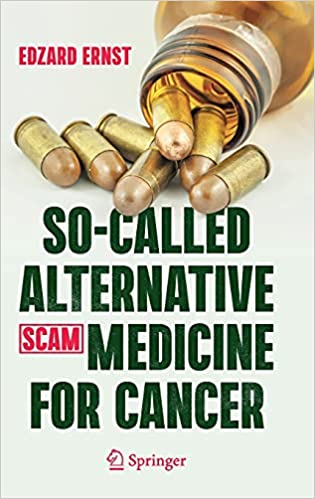
Edzard Ernst definitely knows what he’s talking about. The world’s first professor of complementary medicine, he headed a research team that conducted dozens of clinical trials, did over 300 systematic reviews, and published over a thousand articles in medical journals. He probably knows more about alternative medicine than anyone else in the world. In his latest book, So-Called Alternative Medicine for Cancer, he evaluates alternative medicine’s claims relating to cancer.
Many have argued that alternative medicine is benign and harmless, that it meets psychological needs, that it’s worth trying because it couldn’t hurt and might possibly help. I don’t doubt that alternative medicine may do some subjective good as a placebo. It can provide comfort and can empower patients, letting them feel they are taking action to help themselves and letting them imagine they have some control over an uncertain fate.
But alternative medicine can be deadly for vulnerable patients, especially those with cancer. They are frightened, desperate, and ready to believe any charlatan who offers certainty and hope. They don’t ask whether it might be false certainty and false hope; if it’s false, they don’t want to know. Some of them reject conventional treatments that might have cured them, and they die unnecessarily.
Edzard Ernst is particularly concerned about these potential dangers after what happened during his wife Danielle’s treatment for endometrial cancer. Her nurse tried to convince her that chemotherapy was poison and would cause horrendous side effects. The nurse told her she should refuse conventional treatment and instead follow the anti-cancer diet of Dr. Schwartz, which “would surely cure her”. Ernst promptly fired the nurse and is convinced his wife would be dead today if she had listened to her. Instead, Danielle followed the advice of her oncologist, had conventional surgery, radiation, and chemotherapy, and today is cancer-free.
I have reviewed several of Ernst’s previous books:
- Trick or Treatment: The Undeniable Facts about Alternative Medicine with co-author Simon Singh
- Alternative Medicine: A Critical Assessment of 150 Modalities
- Homeopathy: The Undiluted Facts
- SCAM: So-Called Alternative Medicine
- More Harm Than Good: The Moral Maze of Alternative Medicine co-authored with a medical ethicist
- Don’t Believe What You Think: Arguments for and Against SCAM which he called “a crash course in critical thinking”
In the new book, he starts by explaining why he refers to alternative medicine as SCAM:
It is clearly not an alternative. If a therapy does not work, it cannot possibly be a reasonable alternative to an effective treatment. And if it does work, it simply is part of medicine.
The introductory section explains what evidence is, why it is important, common misconceptions about SCAM, why people are attracted to it, ethical concerns and truly informed consent, science vs. pseudoscience, and why clinical trials can reach false conclusions. Then he proceeds to briefly describe the various SCAM modalities that have been offered to cancer patients in separate sections covering cancer prevention, cancer treatment, and palliative/supportive care. He grades each modality on five factors: plausibility, effectiveness, safety, cost, and risk/benefit balance. He uses the same simple system of colored thumbs that he used in his earlier book Alternative Medicine: A Critical Assessment of 150 Modalities: a green thumbs-up symbol for positive, a horizontal yellow thumb for debatable, and a red thumbs-down for negative.
In two final chapters, he covers the risks of SCAM, interactions between SCAMs and conventional cancer drugs, and published evidence showing that cancer patients who use SCAMs don’t have improved quality of life, are less compliant with prescribed pharmaceuticals, and don’t live as long as patients who don’t use them.
Palliative care
He is scrupulously honest in following the published evidence. He doesn’t disparage anything just for being alternative. He willingly gives good grades to a number of interventions that studies have shown to be helpful in palliative and supportive cancer care. Propolis (for oral mucositis), ginger (for chemotherapy-induced nausea and vomiting), guided imagery, probiotics, and melatonin are rated mostly thumbs up.
Cancer prevention
After reviewing many proposed candidates, he concludes:
Overall, the belief that SCAM plays a major role in the prevention of cancer is built more on wishful thinking than on strong evidence…some supplements could even have a negative influence.
Cancer treatment
Homeopathy gets a thumbs up for safety and cost, but thumbs down for plausibility, effectiveness, and risk/benefit balance. So do prayer, therapeutic touch, and spiritual healing.
In addition to the usual suspects, he covers some modalities that were new to me, such as Lakhovsky’s Oscillator, Powerlight (based on the physics of antimatter!), Factor AF2 (a mixture of liver and spleen cells from sheep embryos), Breuss Cancer Cure, and Danshen.
Conclusion: A very useful manual
This book presents a world of useful science-based information in a very accessible format. The reader can easily look up a SCAM modality and see at a glance from the color-coded thumbs whether it’s worth trying. The people who most need to read this book probably won’t. I wish oncologists would take pre-emptive action against cancer SCAMs by giving each patient a free copy of this book at the time of diagnosis. A few of them might even read it and learn from it.

